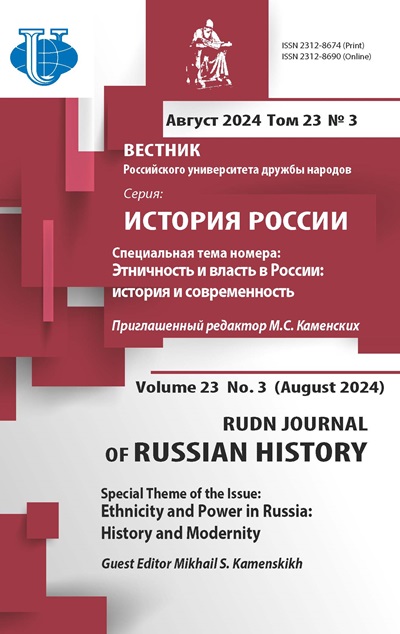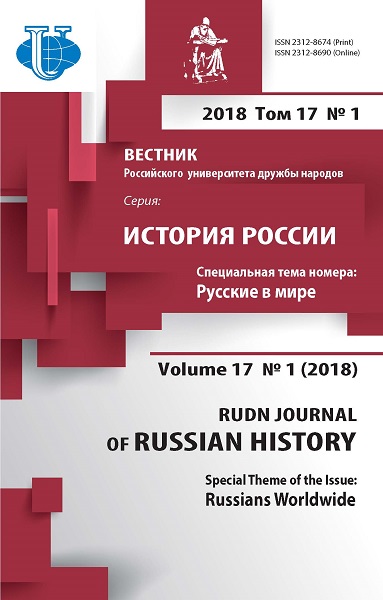Political and legal peculiarities of organization of judicial power and repressive system in the White Crimea in 1920
- Authors: Tsvetkov V.Z.1
-
Affiliations:
- Institute of History and Politics Moscow Pedagogical State University
- Issue: Vol 17, No 1 (2018): RUSSIANS WORLDWIDE
- Pages: 175-197
- Section: ARTICLES
- URL: https://journals.rudn.ru/russian-history/article/view/18536
- DOI: https://doi.org/10.22363/2312-8674-2018-17-1-175-197
Cite item
Full text / tables, figures
Abstract
The article examines the peculiarities of the functioning of the judicial system in the White South of Russia during the 1920s. This period is characterized by a significant departure from the previously proclaimed principles of the ideology of the “White movement”, which were replaced by the so-called “left-wing policy with the right hands”. The author comes to conclusion that due to the reduction of the territory occupied by the White armies (the borders of the Crimea and North Tavria (Tauride Governorate)), it became possible to more closely monitor the work of the local judicial system. The White leadership proclaimed its policy of combating all violations of law, the absence of legitimate methods of government, the rule of the so-called “machine gun right”, in which it was the decisions of the military which became the major ones, they prevailed over all civilian legislative acts and institutions. General Wrangel and the Government of the South of Russia, led by Alexander Vasilievich Krivoshein, the former tsarist minister, managed to achieve some changes for the better. There increased the role of the Governing Senate and the importance of prosecutor’s supervision; the activities of the magistrate courts began to recover. The work of counterintelligence agencies was put under prosecutor’s supervision. Court martial got legal limitations, the Red Army soldiers were pardoned. However, it was not possible to completely overcome the dominance of military justice over civil one and to achieve significant changes in the political and legal system in the conditions of the ongoing Civil War. This became one of the reasons for the weakness of the White rear and the failures of the South Russian White movement.
About the authors
Vasiliy Zh Tsvetkov
Institute of History and Politics Moscow Pedagogical State University
Author for correspondence.
Email: tsvetcov@rambler.ru
доктор исторических наук (Московский педагогический государственный университет (МПГУ), 2010), профессор кафедры новейшей отечественной истории Института истории и политики МПГУ.
88 Vernadsky pr., Moscow, 115571, RussiaReferences
- A.P. Pravosudie v voyskah generala Vrangelya. Constantinople, 1920 (in Russian).
- Argunov, A. “Bez svobody.” [Without freedom]. Na chuzhoj storone, no. 13 (1925): 1921-1925 (in Russian).
- Argunov, A. Beloe delo v Rossii. Formirovanie i jevoljucijapoliticheskih struktur Belogo dvizhenija v Rossii. 1919-1922. Vol. 1. Moscow: Nauka, 2013 (in Russian).
- Buldakov, V.P. Krasnaya smuta. Priroda i posledstvija revoljucionnogo nasiliya. Moscow: Fond “Prezidentskiy centr B.N. El’cina”, Rossiyskaya politicheskaya enciklopediya, 2007 (in Russian).
- Gosudarstvennyy arhiv Rossiyskoy Federacii (thereafter - GA RF) [State archive of the Russian Federation], f. 6611, op. 1, d. 1.
- GA RF, f. 6611, op. 2, d. 4.
- Cvetkov, VZh., and Lubkov, A.V Beloe dvizhenie v Rossii - ego programma i vozhdi [White movement in Russia - its program and leaders]. Moscow: Prometey Publ., 2003 (in Russian).
- Grigor’ev (Genker) “Tatarskiy vopros v Krymu.” [The Tatar question in the Crimea]. Antan- ta i Vrangel’, 232-238. Issue 1. Moscow; Leningrad, 1923 (in Russian).
- Karpenko, S.V. Vrangel’: Poslednij Glavkom. Moscow: AST, 2006 (in Russian).
- Kenez, Peter. Krasnaya ataka, beloe soprotivlenie. 1917-1918. Translated by K.A. Nikifo¬rov. Moscow: ZAO Tsentrpoligraf, 2007 (in Russian).
- Kenez, Peter Podlinnaya istoriya Dobrovol’cheskoi armii. 1917-1918 gg. Moscow: Algoritm, 2017 (in Russian).
- Kroner, Anthony. Belaya armiya, Chernyi baron: zhizn’generala Petra Vrangelya. Mos¬cow: ROSSPEN, 2011 (in Russia).
- Litvin, A.L. Krasny i bely terror v Rossii 1918-1922 gg. Kazan’: Jeksmo, 1995 (in Russian).
- Petrov, G.N. Dialektika sootnosheniya ‘krasnogo’, ‘belogo ’ terrora i terrora interventov v gody Grazhdanskoj vojny v Rossii (1917-1920 gg.). Moscow: MTU, 2000 (in Russian).
- Polyakov, I.A. Donskie kazaki v bor ’be s bol ’shevikami. Munich, 1962 (in Russian).
- Ross, N. Vrangel’v Krymu. Frankfurt on Main, 1982.
- Rukovodstvo dlja Voenno-Sudnyh Komissij, Voenno-Polevyh i Polkovyh Sudov [The manual for Military Commissions Judgment, the Field and Regimental Courts]. Sevastopol’, 1920.
- Taganrogskiy vestnik. Taganrog, December 18 (31), 1919.
- Voennyi golos. Sevastopol, September 16, 1920.
- Voennyi golos. Sevastopol, October 4, 1920.
- Voennyi golos. Sevastopol, October 16, 1920.
- Voennyi golos. Sevastopol, October 20, 1920.
- Vrangel’, P.N. “Zapiski.” [Notes] Part 2. In Beloe delo. Letopis ’beloj bor ’by. Vol. 6. Berlin, 1928 (in Russian).
















